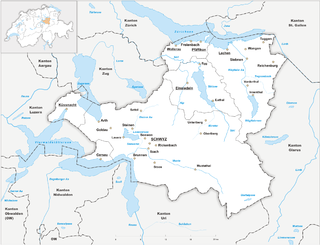
The canton of Schwyz is a canton in central Switzerland between the Alps in the south, Lake Lucerne to the west and Lake Zürich in the north, centred on and named after the town of Schwyz.
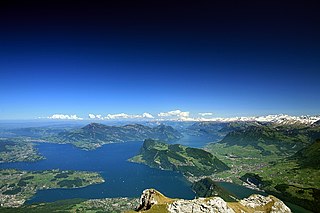
Lake Lucerne is a lake in central Switzerland and the fourth largest in the country.
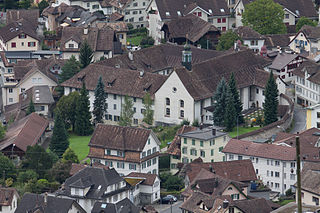
Schwyz is a town and the capital of the canton of Schwyz in Switzerland.

The canton of Lucerne is a canton of Switzerland. It is located in the country's central, German-speaking part. The population of the canton is 416,347. As of 2007, the population included 57,268 foreigners, or about 15.8% of the total population. The cantonal capital is the city of Lucerne.
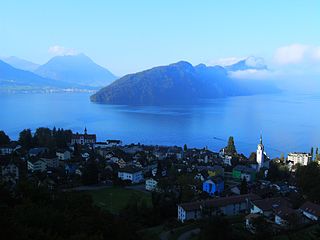
Vitznau is a municipality in the district of Lucerne in the canton of Lucerne in Switzerland.
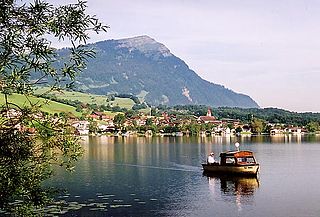
The Rigi is a mountain massif of the Alps, located in Central Switzerland. The whole massif is almost entirely surrounded by the water of three different bodies of water: Lake Lucerne, Lake Zug and Lake Lauerz. The range is in the Schwyzer Alps, and is split between the cantons of Schwyz and Lucerne, although the main summit, named Rigi Kulm, at 1,798 meters above sea level, lies within the canton of Schwyz. The Rigi Kulm Hotel, established in 1816, is located on the summit.

Gersau is a municipality and district in the canton of Schwyz in Switzerland, sitting on the shores of Lake Lucerne. Gersau was for many centuries an independent micro-state in permanent alliance with the Swiss Confederation.

Küssnacht am Rigi is a village and a district and a municipality in the canton of Schwyz in Switzerland. The municipality consists of three villages Küssnacht, Immensee, and Merlischachen, the hamlet Haltikon, the industrial area Fänn, and the alp Seeboden. It is situated at the north shore of Lake Lucerne and at the south shore of Lake Zug below mount Rigi.

Weggis is a municipality in the district of Lucerne in the canton of Lucerne in Switzerland.

Adligenswil is a municipality in Lucerne District in Canton of Lucerne in Switzerland. It is east of the city of Lucerne and borders on canton Schwyz.
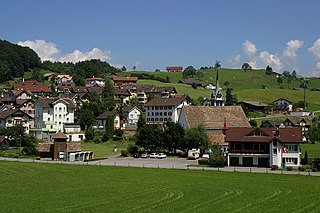
Morschach is a municipality in Schwyz District in the canton of Schwyz in Switzerland. It was a world-famous resort from 1869 up to the Great Depression.

Muotathal is a village and a municipality in Schwyz District in the canton of Schwyz in Switzerland. The eponymous valley, the Muotatal, is formed by the Muota, which joins Lake Lucerne at Brunnen.
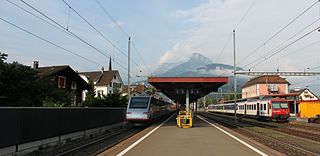
Brunnen railway station is a railway station serving the resort of Brunnen, in the Swiss canton of Schwyz and municipality of Ingenbohl. It is located on the Gotthard railway, and is served by long-distance trains as well as by commuter and suburban trains.

Schwyz railway station is a railway station in the municipality of Schwyz, the capital of the canton of Schwyz in Switzerland. Opened in 1882, it is owned and operated by the Swiss Federal Railways, and forms part of the Gotthard railway, which links northern Switzerland and Immensee with Chiasso and Italy, via the Gotthard Tunnel.

Immensee railway station is a railway station in the municipality of Küssnacht, in the Swiss canton of Schwyz. It located at the junction of three standard gauge lines of Swiss Federal Railways: the Gotthard, Lucerne–Immensee, and Rapperswil–Immensee.

Küssnacht am Rigi railway station is a railway station in the municipality of Küssnacht, in the Swiss canton of Schwyz. It is an intermediate stop on the standard gauge Lucerne–Immensee line of Swiss Federal Railways.
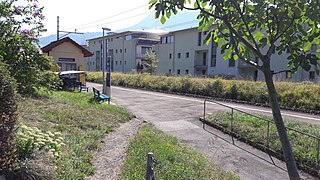
Merlischachen railway station is a railway station in the municipality of Küssnacht, in the Swiss canton of Schwyz. It is an intermediate stop on the standard gauge Lucerne–Immensee line of Swiss Federal Railways.

Steinen railway station is a railway station in the municipality of Steinen, in the Swiss canton of Schwyz. It is an intermediate stop on the standard gauge Gotthard line of Swiss Federal Railways. Steinen has two platforms serving two tracks.

Vitznau railway station is a railway station and ferry terminal in the municipality of Vitznau, in the Swiss canton of Lucerne. It is the terminus of the standard gauge Vitznau–Rigi line of Rigi Railways. The Lake Lucerne Navigation Company (SGV) operates regular ferry service to Lucerne and Flüelen, on Lake Lucerne.

Weggis landing stage is a ferry port in the municipality of Weggis, in the Swiss canton of Lucerne. It is located on a projection of the Rigi mountain that protrudes into the northern part of Lake Lucerne. It is served by the Lake Lucerne Navigation Company.


























